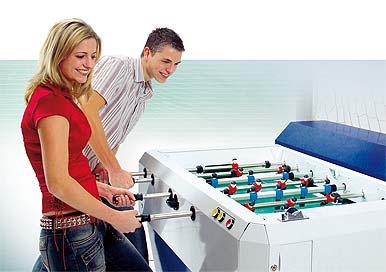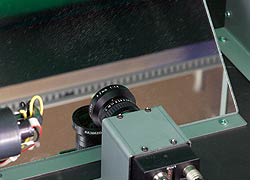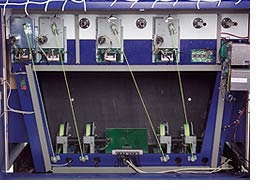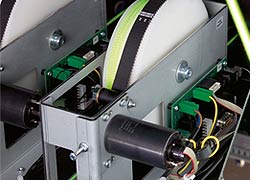 |
| December 17, 2013 | Volume 09 Issue 47 |
Designfax weekly eMagazine
Archives
Partners
Manufacturing Center
Product Spotlight
Modern Applications News
Metalworking Ideas For
Today's Job Shops
Tooling and Production
Strategies for large
metalworking plants
Micromotors give foosball robots the winning edge
These bots are persistent, fast, and (almost) unbeatable.

What looks like a gadget is often serious science with a significant potential for research as well as commerce. Unfortunately, the merits of such work are often underestimated, particularly in Germany. One of the exceptions to this is a research project conducted by the University of Freiburg in cooperation with Gauselmann GmbH, a subsidiary of the Gauselmann Group. Within the framework of a doctoral thesis by Thilo Weigel, the team developed a special piece of software for table soccer (foosball). It is designed to react intelligently to situational moves that are made in the game. Modern processor technology and optical image processing via cameras are deployed for data input and evaluation. Durable, high-speed DC motors perform as actuators. This "game" creates the perfect basis for testing so-called situational software. The commercial success as a table soccer robot is an added bonus of these research activities.
A theory is only good if it also works in practice. With this in mind, the chair for artificial intelligence at the University of Freiburg chose an "interactive" approach when it came to developing its new software that reacts to different situations. The practical test provides valuable information regarding possibilities for improve-ment. One of the essential prerequisites is a complex situation that also demands quick reactions from the program.
A glance "outside the box" quickly shows that there are best-in-class solutions even for such apparently challenging cases. A table soccer game is highly demanding due to its complex play pattern and also because of the high speed of the ball. A controller that can get to grips with this specific problem using the appropriate actuators is also capable of mastering other automated tasks.
Everything that happens in the table soccer robot occurs in an area measuring just 220 x 157 x 121 cm (height, width, depth). Given the complexity of the operation, this can be considered a comparatively compact testing device. The chair for artificial intelligence worked with specialists in the field in order to come up with the best possible "game plan." Micromotor expert FAULHABER contributed its drive know-how to ensure the requisite shooting power and mobility of the unit, while Gauselmann GmbH, renowned as a high-end manufacturer of gaming equipment, was responsible for the practical configuration of the robot.

Functional principle
A PC provides the actual control of the game. An attached camera delivers the necessary data of everything that's happening on the playing field. The PC software evaluates the current camera image every 20 milliseconds. In doing so, it determines the ball position as well as the speed and direction of the ball. Using this data, the program then decides when and how a particular player should be moved. This results in the bars being positioned horizontally, or the bar, and thus the players, being rotated. Thus, the ball can be struck successfully by the players or parried by the goalkeeper.
One of the prime objectives is to handle as little data as possible in order to enhance the actual evaluation process. State-of-the-art data capture and work distribution are essential. An infrared camera observes everything that is happening from below through the transparent playing field. A "floodlight" with approximately 300 infrared light emitting diodes on the border illuminates the playing field. The playing surface itself is covered with an infrared-permeable filter film, so that only the infrared rays reflected by the ball are detected by the camera. This facilitates the evaluation process when registering the ball.
The stream of data to the actuators is also minimized. Here, the controller PC only issues superordinate commands such as: "right," "left," or "shoot." The actual fine-tuning is performed by subordinated control units.
The table soccer robot uses standard FAULHABER Motion Controllers for this purpose. The game is brought to life thanks to minimal computing times, which in turn are a result of the streamlined data set and the reduced delay times.

Player drive
In contrast to professional soccer, the Star Kick Robot is capable of "motivating" its players without the lure of mega salaries. All it takes is two motors for each bar. Drives positioned on the base plate of the device move the players horizontally via cable pulls in the bars. The cable is looped around the respective driving drum several times and is prevented from slipping through as a result of increased friction. This ensures an accurate, synchronous control of the players. The developers used a belt drive on the rear of the device to control the shooting power, i.e. the rotation of the players.
The motors have to move very dynamically in this application, but only ever for a brief moment. The Schonaich-based drive specialist therefore recommended the use of quick-running standard DC motors with carbon brushes. These durable motors can reach a peak power output of over 220 W, which means that they have more than enough power for the players.
Each driving motor has a magnetic pulse generator to communicate the respective player positions to the controller. At 512 pulses per revolution, the resolution is so fine that no ball can evade the players' feet. A motion controller provides the actual control of the motor and angular momentum processing. At the start of play, it drives the players into a defined starting position and then evaluates the speed sensor data. The data processed in this way is sent to the PC via an RS232 interface. This then responds by issuing the information for the control of the players. The controller then converts this into electrical impulses for the motor. Cable or belt sheaves provide the correct reduction during play.

Taking into account the required acceleration values, the transmission is designed in such a way that ensures the motors operate within the optimal speed range. Combining tailor-made design and high-performance drive technology, the specialists involved in the project have been able to deliver solutions which were considered impossible just a few years ago. Indeed, today even the highly efficient range of standard products available within the area of micro-drives is capable of mastering complex tasks. All it takes is creativity and skill -- and state-of-the-art drive systems providing the necessary momentum.
Video: The computer-controlled foosball team is in blue.
Learn more about micro-drives from MICROMO at www.micromo.com.
Source: MICROMO
Published December 2013
Rate this article
View our terms of use and privacy policy
